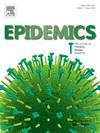使用结构化聚合模型和出生-死亡模型估计病原体传播:定量比较。
IF 2.4
3区 医学
Q2 INFECTIOUS DISEASES
引用次数: 0
摘要
阐明疾病在亚群之间的传播对于指导有效的疾病控制工作至关重要。基因组流行病学和系统动力学已成为从分子数据得出的病原体系统发育中估算这种传播的关键原则。基于聚合模型和出生-死亡模型的两种成熟的结构系统动力学方法经常被用来估算病毒在种群间的传播。然而,这些方法在不同的假设条件下运行,其对迁移率推断准确性的影响还有待深入研究。在本手稿中,我们进行了一项模拟研究,对比了具有恒定种群规模的结构化聚合模型和具有恒定迁移率的多型出生-死亡模型的推论结果。我们探讨了在地方病和流行病爆发的一系列迁移率下的这种比较。流行病爆发分析的结果表明,与凝聚模型相比,无论实际迁移率如何,出生-死亡模型在检索准确迁移率方面都表现出更强的能力。因此,要估算准确的迁移率,就必须考虑到人口动态。另一方面,对于地方病情景,我们的调查表明,两种模型的覆盖范围和迁移率的准确性相当,而凝聚模型的估计结果更为精确。无论具体情景如何,两种模型对疾病来源地点的估算结果相似。这项研究为传染病分析人员提供了切实可行的建模建议,建议对地方病使用两种模型中的任何一种。对于流行病爆发或人口规模变化的情况,应避免使用依赖于人口规模恒定的金曼聚合的结构化系统动力学模型,因为它们可能导致对迁移率的不准确估计。取而代之的是考虑不同种群规模的凝聚模型或出生-死亡模型。重要的是,我们的研究强调了直接捕捉指数增长动态的价值,这对结构化凝聚模型是一个有用的增强。本文章由计算机程序翻译,如有差异,请以英文原文为准。
Estimating pathogen spread using structured coalescent and birth–death models: A quantitative comparison
Elucidating disease spread between subpopulations is crucial in guiding effective disease control efforts. Genomic epidemiology and phylodynamics have emerged as key principles to estimate such spread from pathogen phylogenies derived from molecular data. Two well-established structured phylodynamic methodologies – based on the coalescent and the birth–death model – are frequently employed to estimate viral spread between populations. Nonetheless, these methodologies operate under distinct assumptions whose impact on the accuracy of migration rate inference is yet to be thoroughly investigated.
In this manuscript, we present a simulation study, contrasting the inferential outcomes of the structured coalescent model with constant population size and the multitype birth–death model with a constant rate. We explore this comparison across a range of migration rates in endemic diseases and epidemic outbreaks. The results of the epidemic outbreak analysis revealed that the birth–death model exhibits a superior ability to retrieve accurate migration rates compared to the coalescent model, regardless of the actual migration rate. Thus, to estimate accurate migration rates, the population dynamics have to be accounted for. On the other hand, for the endemic disease scenario, our investigation demonstrates that both models produce comparable coverage and accuracy of the migration rates, with the coalescent model generating more precise estimates. Regardless of the specific scenario, both models similarly estimated the source location of the disease.
This research offers tangible modelling advice for infectious disease analysts, suggesting the use of either model for endemic diseases. For epidemic outbreaks, or scenarios with varying population size, structured phylodynamic models relying on the Kingman coalescent with constant population size should be avoided as they can lead to inaccurate estimates of the migration rate. Instead, coalescent models accounting for varying population size or birth–death models should be favoured. Importantly, our study emphasises the value of directly capturing exponential growth dynamics which could be a useful enhancement for structured coalescent models.
求助全文
通过发布文献求助,成功后即可免费获取论文全文。
去求助
来源期刊

Epidemics
INFECTIOUS DISEASES-
CiteScore
6.00
自引率
7.90%
发文量
92
审稿时长
140 days
期刊介绍:
Epidemics publishes papers on infectious disease dynamics in the broadest sense. Its scope covers both within-host dynamics of infectious agents and dynamics at the population level, particularly the interaction between the two. Areas of emphasis include: spread, transmission, persistence, implications and population dynamics of infectious diseases; population and public health as well as policy aspects of control and prevention; dynamics at the individual level; interaction with the environment, ecology and evolution of infectious diseases, as well as population genetics of infectious agents.
 求助内容:
求助内容: 应助结果提醒方式:
应助结果提醒方式:


